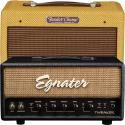
Due to the use of old valve technology, it’s natural for valve amps to have subtle sound artifacts like tube buzz and hum. But too much buzz can be an indication of a problem somewhere in the system.
Instead of a light hum bringing an interesting layer to your music, the noise can be loud enough to overpower your sound. This results in an unappealing tone, worse, render your amp unusable.
The cause can be a number of things, a dying tube, a fault in the amp, or it may be the result of electrical interference. Thankfully, this type of problem is fixable. While unwanted noise can be hugely frustrating, it doesn’t always mean your amp is no longer working.
In this guide, I’ll walk you through some of the causes of tube buzz and potential solutions. Hopefully, with some minor adjustments, you should be able to get the noise levels down to normal.
What Is Tube Buzz?
Tube amplifiers use glass valves to transport and amplify an electrical signal. As the signal is pushed through the tubes, you start to hear distortion.
This buzzing is distortion and adds warmth to your tone, creating the warm overdriven guitar sound that many love. As you turn the volume up higher, the tubes are pushed harder, and the “buzz” increases.
It’s somewhat similar to a warm trumpet buzz, which is achieved by good mouthpiece practice.
Distortion or overdrive is desirable to a certain extent, but excess tube buzz due to faulty tubes or electronics distracts from the sound. This additional noise can quickly become annoying.
Sometimes, it might even drown out the sound of your playing. If your tube amp has started buzzing and humming beyond comfort, you need a way to fix the problem.
Extraneous Noise And Tube Amps
Tube amps are going to produce some noise. That’s a physical limitation of this old technology. If you want a sound with greater clarity, it might be worth switching to a solid state guitar amp instead. At the end of the day, the effort of pushing and amplifying a current means some level of buzz is standard in any amplifier.
Before you begin switching out your guitar amps, it’s important to understand the noises a tube amp can produce. From here, you can decide what’s normal, what needs fixing, and how to solve the issue:
Noise floor. The noise floor, or self-noise, is the noise created by the amp itself. When you turn an amp on, this is what you can hear. Tube amps have a higher noise floor than solid-state amps. The noise floor shouldn’t cause a problem. When you start to play, it should meld into the background.
Gain and volume. As the gain increases, so does the distortion. When you crank gain and volume settings, you’re pushing the tubes harder, causing buzz. Try reducing the gain while increasing the master volume. This should help produce a cleaner tone. Having a good audio limiter can also help prevent unwanted loud buzzes.
Hiss. A little hiss isn’t unexpected in a tube amp. As with the noise floor, it should essentially disappear when you start to play. If the hiss is noticeable even above your instrument, then you probably need new tubes.
Troubleshooting Tube Amps And Buzz
There are a few different reasons why a tube amp might start buzzing. They range from easy fixes to more complex problems from other sources. If you’ve bought a new tube amp, it’s worth giving it a few days to settle in. If the noise is still a problem, it’s time to start troubleshooting.
Find The Problem
The first step is determining if the problem is actually caused by the amp. The amp is just one part of a chain passing an electrical current. It’s entirely possible the problem is coming from elsewhere in the chain, leaving you with more options to troubleshoot.
You can quickly eliminate external factors if you have another working tube amp to compare with.
If you don’t, then experiment with a new configuration for powering your rig to eliminate the noise. Change the power cable, or plug into a different power outlet, and listen for improvements. I was surprised one time when I got a more positive response about my tone when I simply switched to a different outlet. It’s best that amps and Light Fixtures are not connected directly to the same power source.
Disconnect any cables and pedals connected to the amp. Listen for the hum. If it has stopped, the problem might be a cable or pedal. If the amp is not the source, then you might want to look into using using a Noise Gate.
Check For Electrical Hum and Guitar Hum
The amp buzz might be the result of an external source. Fluorescent lights and smartphones are both common causes of tube buzz. If they’re too close to the amp or instrument, they can disrupt the electromagnetic current, leading to buzz.
The solution here is distance. Try moving away from the lights or the phone, and see if the buzz lessens.
Another issue might be the guitar itself. The guitar pickup can interrupt the signal if it gets too close. You’ll notice the buzzing increases when you step toward the amp. Again, distance can help. Single coil pickups are also notorious for making noise. Try playing a humbucker equipped guitar and see if your sound improves.
It goes without saying that cables can also be a culprit, hence the instruction earlier to unplug everything first.
Condition Dirty Power
Combating dirty power can ensure you have a healthy system that lasts longer. Good system hygiene is an excellent way to eliminate issues in your power supply set-up. It can also remove frustrating excess buzz from an amp.
The best solution for dirty power is a power conditioner. You can get power conditioners with built-in noise-filtering technology that are ideal for amps. Combine this with quality cables and a separate electrical island for your rig. Good system hygiene can prevent a lot of long-term problems.
Ground The System
If the problem persists, you probably need a better ground connection. A ground loop picks up excess electromagnetic energy, disrupting your signal. You can identify this problem by lifting the ground and listening for buzz. If it’s still there, you have a ground loop.
You can fix a ground loop hum using a ground loop cable. They ground the interference for a cleaner sound. A ground loop cable can be picked up for relatively cheap from hardware stores and audio equipment stores.
Amp issues and Power Tube Failure
Buzz can be due to cabinet components getting loose, and shaking. This is usually easy to troubleshoot and fix – the best way is to just tighten the components to prevent them from moving. Check all the components, things like the main circuitboard (if not wired point to point) and potentiometers. If you have experience with electronics, you can also inspect the tube mounts, enclosure, tube heaters, and center tap.
Hum, hiss, and buzz can also be caused by a power tube dying. When a tube is dying, it isn’t capable of handling high voltages and stops canceling out the hum of a power transformer. This then results in irritating background noise. If your tubes are close to their end of life, then they are probably the culprit. Many experience this same problem, and is one of the reasons why some prefer solid state when choosing between Tube Amp vs Solid State.
While this can happen, it can be an expensive fix. Work through the other issues on the list to eliminate all possibilities before getting the tubes changed. If you default to this option immediately, you might pay a lot of money only to find the problem continues.
Frequently Asked Questions
Why Is My Amp Buzzing?
Any tube amp will have some level of buzz caused by electrical currents traveling through the tubes. You can potentially reduce this by lowering gain and increasing the master volume. Excess and unwanted noise might be a result of a fault in the amp or your signal chain. Locate the source of the noise, isolate it to fix the issue. If you’re annoyed by low volume hum, then consider adding a ground loop cable.
Should My Tube Amp Hum?
A little bit of hum and buzz is inherent to an amp. It can add warmth to a sound, particularly when the volume is turned up. Excess buzz disrupts the sound and can create a discordant noise. If the tube buzz is disturbing your playing, you need to locate and troubleshoot the problem.
Conclusion
A tube amp uses analog components to amplify an electrical signal. So, when the amp is turned on, it’s going to make a light buzzing noise. This becomes an issue when this buzz affects the quality of the sound.
When tube amp buzzing becomes a distraction, you need to identify the source. Use a methodical approach to test the different options. When you know the issues, you can find the solution.
While tube amp hum can add warmth to a sound, too much is frustrating. I hope this guide has helped you understand, and fix, any tube buzz.


 The Best Small / Low Watt
The Best Small / Low Watt  The Best Guitar Amp from the
The Best Guitar Amp from the 
